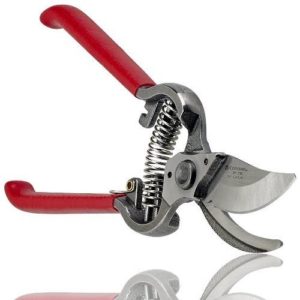
- Easy cutting
- Sap groove
- Wire cutting notch
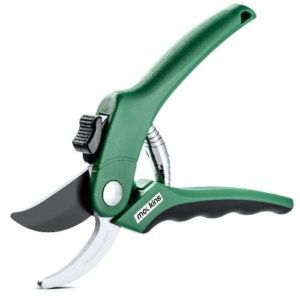
- Safety lock
- Ergonomic rubber handles
- Stainless steel blades
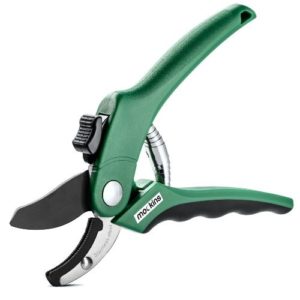
- Safety lock
- Ergonomic rubber handles
- Stainless steel blades
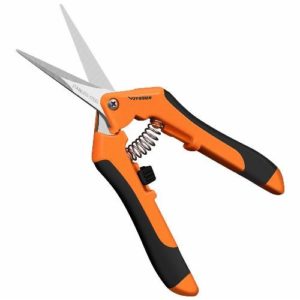
- Reduce hand strain
- Ultra sharp blades
- Easy to operate lock
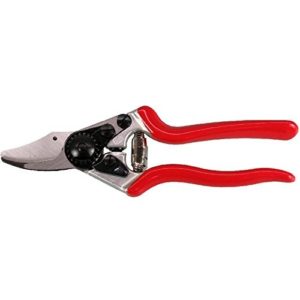
- Comfortable to use
- For small pruning work
- Made for smaller hands
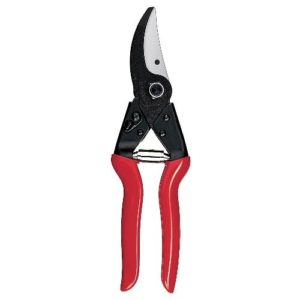
- All purpose shears
- Blades are replaceable
- Sturdy steel handles
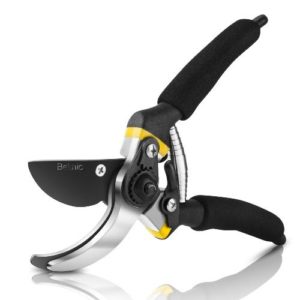
- Precision steel
- No more hand fatigue
- Heavy-duty telescopic spring
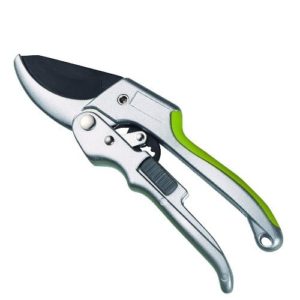
- Effortless cutting
- High quality steel blades
- Ergonomic comfortable design
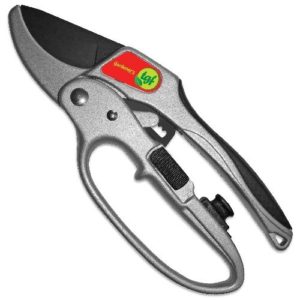
- Perfect for trimming flowers
- No more painful pruning
- Quick and easy cutting
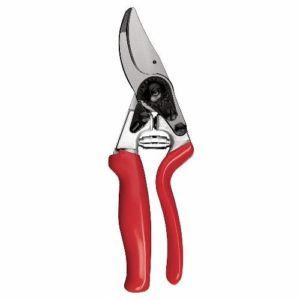
- 30% less effort
- Cutting and anvil blades
- Offers maximum comfort
Choose the Best Pruning Shears
Customer’s Choice: the Best Rated Pruning Shears
9 users answered this survey. Please help us improve this review!
Your garden needs pruning from time to time. Plant, irrigate and prune – these are major things to do whenever you are a small garden or large park owner. Professional gardeners and amateur green thumbs need a good pair of pruning shears (pruner).
This instrument can handle any small pruning jobs – from trimming begonias on the front lawn to cutting the designer hedges and boxwoods of a huge estate. These tasks can be handled effortlessly only if you have sharp and durable shears with a comfortable grip. Just like any other high-quality tool, premium pruning shears can serve for a few years, if not decades.
Below you can find the description of the most popular pruning shears with unique features. You will find out how to select pruners – from size to cutting capacity (how thick branches can be trimmed by pruners). Check the highlights about each instrument and compare them to other shears from the list before making the final decision.
Table of Contents
Corona BP 3180D – the best bypass hand pruner!
 This popular Corona bypass hand pruner is awesome with cutting 1-inch hedges, bushes and tree twigs. Its blade is made of forged steel alloy. That is why many professional gardeners prefer using this model.
This popular Corona bypass hand pruner is awesome with cutting 1-inch hedges, bushes and tree twigs. Its blade is made of forged steel alloy. That is why many professional gardeners prefer using this model.
This small hand pruner has a great spring-based mechanism. It stays free until you finish the job. Then you should squeeze the handles towards each other. Pull the catch to the clip to close them.
A few other models are available in this lineup, with the different cutting capacity. This instrument delivers very precise and clean cuts. Keep in mind that this pruner will handle only large branches and small bushes. If you require heavy-duty pruners, check the Corona Bypass model with 3.4-inch cutting capacity.
Mockins Professional Bypass Pruner – the best for handles!
 This Mockins bypass hand pruner has very sharp, long and stainless steel blades. It is good for both right-hand and left-hand gardeners. Gardeners with small or medium-size hands and elderly people prefer buying them because they are lightweight.
This Mockins bypass hand pruner has very sharp, long and stainless steel blades. It is good for both right-hand and left-hand gardeners. Gardeners with small or medium-size hands and elderly people prefer buying them because they are lightweight.
These lightweight pruning shears are more like basic garden clippers. It is a perfect choice for small garden owners who need to cut through the plants, flowers and herbs occasionally. Some people won’t be able to extend the blades to the fully open position because the grips are wide.
Mockins Professional Anvil Shears – the best anvil hand pruner!
 These professional Mockins pruning shears are strongly recommended for cutting tree twigs, sprigs, bushes, shrubs, shoots in gardens. It is a very popular tool chosen by first-time gardeners and professional landscapers.
These professional Mockins pruning shears are strongly recommended for cutting tree twigs, sprigs, bushes, shrubs, shoots in gardens. It is a very popular tool chosen by first-time gardeners and professional landscapers.
Just like all Mockins shears, this instrument has stainless steel blades capable of cutting through any wood materials.
Trim, clip, cut and shear with the Mockins anvil hand pruner. This heavy-duty instrument may serve for a few years, if not years.
VIVOSUN 6.5 Inch Pruner – the best for portability!
 The Vivosun 6.5-inch hand pruner is a gardening tool for professional and home use. It has straight blades capable of cutting through roses, bushes, twigs, foliage, etc. This is one of the lightest options in the U.S. market. Another great feature is long, narrow micro-tips for making clean and precise cuts.
The Vivosun 6.5-inch hand pruner is a gardening tool for professional and home use. It has straight blades capable of cutting through roses, bushes, twigs, foliage, etc. This is one of the lightest options in the U.S. market. Another great feature is long, narrow micro-tips for making clean and precise cuts.
These bright-colored shears are recommended for reducing hand strain. It is especially useful if a gardener has carpal tunnel syndrome or arthritis. This pruner is appreciated for its versatility – can cut through wood, cardboard or food.
FELCO 7.25″ Anvil Pruner – the best for cutting efficiency!
 The FELCO pruner has sharp anvil blades that are fully adjustable. This tool has a cushioned shock absorber for better cutting efficiency. Thanks to this Swiss hand pruner, you can cut through twiggy branches close to the trunk.
The FELCO pruner has sharp anvil blades that are fully adjustable. This tool has a cushioned shock absorber for better cutting efficiency. Thanks to this Swiss hand pruner, you can cut through twiggy branches close to the trunk.
This instrument is comfortable for small and large hands. Before the purchase, do not forget to select the hand orientation. By default, these shears are not good for left-handed gardeners.
The Buyer’s Guide
Type
As you might have noticed, there are two major types of pruning shears:
- Bypass shears are very similar to any gardening scissors. Such pruners slide one blade past another when cutting the branch. Typically, bypass shears work better when you need to trim live plants and small twigs. Though, you should check the cutting capacity for each instrument;
- Anvil pruners work in a different way. When you squeeze the handle, the upper blade is forced through the twig until the lower blade (it is called the anvil) makes the cut. Typically, these pruning shears are great for cutting dry or dead plants. They may be perfect for trimming wood fibers. If you use anvil pruners to cut through live plants, some sap can build up on them. Some anvil tools offer a ratcheting action to cut through thick or tough woods;
Size
The weight and length of blades are the most important factors to consider when buying pruning shears. At first, you should check the size of your hands and figure out how much weight you would be able to handle effortlessly. Some pruners are specifically designed small for small hands. Also, they are made from many different lightweight materials. However, some instruments are much heavier than the others.
Ease of use
Trimming and pruning can become a challenge. However, the right pair of pruners can make this problem disappear. Ergonomic handles with rubber inserts are built for additional comfort. Besides the handles, a few factors may affect how easy the pruners are to use. Some handles are made specifically for people with limited abilities because arthritis, age, diseases, etc. Good shears should be easy to hold. You should be able to close and open them with one hand, without effort.
Blade quality
Another important factor is the sharpness and quality of the pruner’s blades. Almost all shears come with sharp steel or stainless steel blades with anti-rust coating. Good instruments have the blades made from carbon or tempered steel. If you want to protect the tool from quick rusting, check the shears with a titanium or chrome plating over both blades. This is the difference between premium and cheap pruning shears. Only the best instruments will stay sharp for a long time.
Also, check how the blades of a particular pruner can be sharpened. Occasionally, any gardening instrument has to be cleaned and sharpened. Otherwise, the pair of pruners can get dull and rusty in a few weeks of heavy use.
Locking mechanism
Most anvil and some bypass pruning shears have a special locking mechanism to prevent any accidents. Such a safety mechanism will automatically lock the pruners after use to prevent the blades from being damaged. Also, pets and little kids won’t get hurt by sharp blades.
The locking mechanism must be easy to use – you should open and close the shears without any effort. The shears should not get locked or opened by accidents. For instance, when then the instrument has been fallen and bumped. Also this lock can’t get in the way of normal use when you prune the branches.
How to care for pruning shears?
Before using a shear check if it is dirty or gummed with sap. The thing is sap can be very corrosive and, even if you have the best pruning shears, they will get covered with rust. This is how you may clean and care for the dirty and rust-covered shears:
- Remove debris and dirt from the blades and handle with a stiff brush. You may use warm water and a syringe with a mild soap solution. Rinse the cleaned part with the detergent;
- Make sure to clean the entire surface of the blade. Only then rinse with clean water;
- Check the cutting surface of the blades for rust. Use thin sandpaper to polish and remove any signs of rusty stains on the edges of the pruning shears;
- Add one part bleach to nine parts of water in a bucket. Immerse the blades in this bleach solution and leave them for 3 minutes. The bleach product will disinfects the blades by killing any pathogens that are dangerous to live plants;
- Wipe the blades with a clean, dry cloth after the bleach disinfection;
To lubricate the pruning shears, you may follow these steps:
- Dip a cloth in the grease/engine oil and rub a thin layer of this substance over all the metal surfaces. You may spray the lubricant instead of rubbing;
- Sand and other coarse blotches on the wooden handles of the pruning shears should be removed by means of thin sandpaper;
- If the pruning shears have wooden handles, rub them with linseed oil so that they do not lose natural moisture. Otherwise, the wooden handles can quickly get cracks and chips;
A sharp, clean and lubricated pruner will serve for many years, but blunt knives and rusty spring mechanisms of the tool can easily make it useless. Dirty shears can contain bacteria and pathogens from the infected plants.
If you use the pruning shears without proper cleaning, they may spread these diseases to healthy plants. Do not forget to clean and lubricate the pruner use before the winter season.
Top U.S. brands of shears for cutting
Readers of this blog often ask me about different U.S. brands for garden-ready cutters, saws, and pruners. I often tell them that every popular brand has successful models. It is a matter of individual preferences, but my team agreed that the following brands manufacture great shears for pruning:
- Corona has a vast line of instruments that come in various blade sizes and designs of great quality. But their price is also great, though the warranty policy may cover the cost;
- Fiskars offers durable hedge shears and scissors with awesome performance levels. The prices are more reasonable;
- Felco – durable, smooth, simple to repair and sharp enough to cut any branch in your yard. However, sometimes their price policy is too much for modest budgets.
Video Tutorial: How To Make Your Tools Last Forever: Pruner / Secateur Care & Repair
Why should customers trust our review?
My 10-year experience of taking care after apple trees and rose bushes in my yard speaks for itself. And my best friend is a professional landscaper, so he helps me a lot with this project. Specifically, for this review, we have tested the favorite pruners chosen by many expert landscape designers. After a few days of testing, the collective mind of PoleSawGuide picked a few great shearing tools for cutting.
Factors to Consider When Buying Pruning Shears for Trees
When it comes to pruning trees, having the right pruning shears can make all the difference. There are several factors to consider when choosing pruning shears, including the size and type of the blades, the handle material and design, and the cutting capacity.
The following table compares various indicators for pruning shears:
| Indicator | Description |
|---|---|
| Blade Length | The length of the blade, measured from the tip to the pivot point. |
| Blade Material | The material used for the blade, which can affect its sharpness and durability. Common materials include stainless steel and carbon steel. |
| Blade Type | The shape of the blade, which can vary depending on the type of pruning being done. Common blade types include bypass, anvil, and ratchet. |
| Handle Material | The material used for the handles, which can affect grip and comfort. Common materials include plastic, rubber, and metal. |
| Handle Design | The shape and size of the handles, which can vary depending on the user’s hand size and strength. Common designs include straight, curved, and ergonomic. |
| Cutting Capacity | The maximum diameter of branches that the shears can cut through, which can vary depending on the size and strength of the blades. |
| Weight | The weight of the shears, which can affect comfort and ease of use. Lighter shears are generally easier to use for extended periods of time. |
This table provides a quick reference guide for the key factors to consider when purchasing pruning shears for trees. By considering these indicators and choosing the right shears for your needs, you can ensure that your pruning tasks are completed quickly and efficiently.
FAQ
Which pruning shears are best?
The definition of ideal pruning shears will be different depending on the sort of plants or trees you want to trim. You have two options: bypass pruners and anvil pruners.
Bypass pruners have two sharp blades that overlap each other. These are the best type of pruners to use on living plants because they make a fine cut that won’t do any excess damage to the plant. Anvil pruners have one sharp blade that cuts against a flat surface. These are better for dead or woody plants because they can make a rough cut that would damage more delicate plants. Bypass pruners are good for light to medium gardening work while anvil pruners are ideal for hard-duty tasks. [1], [2]
What garden shears does Monty Don use?
Monty Don, one of the most well-known and respected gardeners in the UK, has Tobisho shears in the list of his most trusted gardening tools. One of his pieces of advice to all aspiring gardeners is to invest in the best tools you can afford, and Tobisho SR-1 Secateurs is one of the examples.
These Japanese made shears are hand-forged from a high carbon steel alloy and are known to be extremely hard. This makes them extremely tough and durable while still maintaining a keen edge. Even branches as wide as 20mm won’t have a chance.
The grip of the Tobisho shears is pretty lightweight and has an ergonomic design which makes them comfortable to use, even for extended periods of time. Plus a security catch at the bottom makes the shears easy to use even with wet or muddy hands from all the work in the garden! [3], [4]
Are Fiskars pruning shears good?
Fiskars is a well-known name in the gardening world, and their pruning shears are no exception. These shears are made of high-quality steel and feature a comfortable grip, making them ideal for those with larger hands, so working with them is free of any hassle. What’s more, the blades are covered with a non-stick material, which makes cutting through tough branches a breeze. [5]
What is the difference between pruners and shears?
Pruners are usually smaller than shears, with narrower blades that taper to a point. Shears have broader, straighter blades with the spring between them. Both pruners and shears can be used for a variety of tasks, but pruners are typically better for small, delicate cuts while shears are better suited for fast pruning of thicker branches or bushes. [6], [7]
How do I choose a garden shear?
When choosing a pair of pruning shears, look for a comfortable grip, sharp blades, and a locking mechanism. The most important thing is to find a pair that feels good in your hand and is the right size for your needs.
The best pruning shears will vary depending on what type of plants or shrubs you are looking to trim. Prioritize the quality of the blade when buying, Sk-5 steel blades are the best blades quality wise on the market and will guarantee a great quality of pruning job. Choosing garden shears with an ergonomic handle is important as well, you don’t want to strain your palms too much after hours of hard repetitive work. [1], [2]
Where are Jakoti shears made?
Jakoti shears are made in Greece and have been around for years. The company has a long history of making tools of an amazing quality, and their pruning shears are no exception. Jakoti shears are made from high-carbon steel, and are designed to be both durable and lightweight. Jakoti constantly improves on the design of their shears, improving their quality with each time.
Jakoti pruning shears are popular with professional gardeners and horticulturalists who need a reliable and durable gardening tool. [8], [9], [10]
What are topiary shears?
Topiary shears are designed specifically for shaping live plants, such as bushes and hedges. They have long, sharp blades that can easily cut through bush branches without crushing them. Topiary shears have wide blades, which makes it easier to prune your bushes. If you’re interested in creating beautiful shapes with your plants, then topiary shears are definitely the way to go. However, they can be a bit more expensive than regular pruning shears. [11]
What shears can I use to cut thick branches?
When it comes to cutting thick branches, anvil shears are the way to go. These are strong tools designed specifically for that purpose.
However, you may sometimes require something more powerful than your basic pair of pruning scissors. Loppers are an excellent choice for that task. Loppers are a type of shear that has long handles and is designed for cutting thick branches. They usually have big and strong blades, which makes them ideal for cutting through thicker wood. [1], [2]
What tool is used for cutting small branches?
The best instrument for cutting small branches are pruning shears. They’re also known as hand pruners or secateurs. Pruning shears have two blades that join together like scissors to make a clean cut on the branch.
For small, delicate branches, you can’t go wrong with bypass pruning shears. They are small, compact and come with curved blades that give you more control over getting the required angles when cutting tiny plants. And they won’t damage them too much at that. [1], [2]
What is the most common part of a tree used to prune?
Branches are the parts of the tree that grow out from the trunk and are generally made up of leaves, flowers, and fruits. Pruning them is important to maintain the tree’s shape and size, as well as to remove any dead or diseased parts of the tree. Pruning shears are the tools that are specifically designed to prune thin wood such as branches.
Limbs also need to be pruned for the health of the tree. They can become overgrown, diseased and weak, and if they are not trimmed back, they can break and fall off, which can be dangerous. Pruning shears are also used to trim back these limbs. [12], [13]
How do I properly clean and maintain my pruning shears?
To clean and maintain your pruning shears, you should first wipe them down with a clean, damp cloth after each use to remove any dirt or debris. You should also regularly oil the blades to prevent rust and keep them lubricated. Additionally, you should sharpen the blades at least once a year using a sharpening stone or file to ensure a clean cut.
Can pruning shears be used for anything other than pruning plants?
While pruning shears are primarily designed for pruning plants, they can also be used for other tasks, such as cutting wire or thin metal sheets. However, it’s important to note that using pruning shears for non-pruning tasks can dull the blades and potentially damage the tool.
How do I know when it’s time to replace my pruning shears?
You should consider replacing your pruning shears when the blades become dull or damaged, or when the handles become loose or bent. Additionally, if you find that you are struggling to make clean cuts with your pruning shears, it may be time to invest in a new pair.
What is the best way to store pruning shears?
The best way to store pruning shears is in a dry, secure location, such as a tool shed or toolbox. It’s also a good idea to keep them in a protective sheath or cover to prevent them from getting damaged or dull over time.
Can left-handed people use pruning shears?
Yes, left-handed people can use pruning shears. However, it’s important to look for pruning shears that are specifically designed for left-handed use to ensure optimal comfort and ease of use.
How do I safely use pruning shears?
To safely use pruning shears, you should always wear protective gloves and eyewear to prevent injury. It’s also important to use the tool with proper technique, keeping your fingers away from the cutting blades at all times. Additionally, you should never force the tool or use it to cut branches that are too thick, as this can damage the blades and potentially cause injury.
Can pruning shears be sharpened at home, or should I take them to a professional?
Pruning shears can be sharpened at home using a sharpening stone or file, but if you’re not confident in your sharpening skills, it may be best to take them to a professional. A professional can ensure that your pruning shears are sharpened correctly and that the blades are properly aligned for optimal performance.
What are the different types of pruning shears, and when should I use each one?
There are several different types of pruning shears, including bypass, anvil, and ratchet. Bypass pruning shears are best for cutting live branches, while anvil pruning shears are better suited for cutting dead or dry branches. Ratchet pruning shears are designed for cutting thicker branches and have a mechanism that helps you make the cut with less effort.
What size pruning shears should I use?
The size of pruning shears you should use depends on the size of the branches you’ll be cutting. For smaller branches, a pair of hand-held pruning shears will work well. For larger branches, you may need a pair of loppers or a pruning saw.
Can I use pruning shears on any type of plant?
While pruning shears can be used on most types of plants, it’s important to choose the right tool for the job. For example, if you’re pruning delicate flowers or foliage, you’ll want to use a pair of sharp, fine-tipped pruning shears. For larger, woody plants, you may need a pair of loppers or a pruning saw.
What are the benefits of using pruning shears?
Using pruning shears can help promote healthy plant growth by removing dead or damaged branches and shaping the plant. It can also improve the plant’s overall appearance and increase its fruit or flower production. Additionally, pruning can help prevent the spread of disease and pests throughout the plant.
Final thoughts
Pruning shears should be sharp, durable and easy to use. Check a few instruments before choosing them. Keep in mind that some pruners are good only for small tasks because they are lightweight. Some pruners are not good for large hands. You should get the maximum comfort when using the best pruning shears.
All models mentioned in this review were chosen due to their exceptional performance. You’re free to offer other shears for pruning, don’t forget to describe why you prefer them. The video tutorial aims at helping to use shearing tools safely. Thanks for reading this review – we’ve put a lot of effort into this research!
References:
- https://gardenbeast.com/best-pruning-shears/
- https://www.gardenbetty.com/best-pruning-shears/
- https://hayfarmguy.com/what-pruning-shears-does-monty-don-use/
- https://www.burford.co.uk/garden/garden-tools/japanese-garden-tools/japanese-secateurs-tobisho-sr-1/
- https://bovees.com/fiskars-best-pruners-loppers/
- https://www.plantgardener.com/pruner-vs-shears/
- https://www.doityourself.com/stry/pruning-when-to-use-a-lopper-vs-pruner-vs-shears
- https://handshears.co.uk/
- https://www.arthurandstrange.co.uk/product-category/brands/jakoti/
- https://handshears.co.uk/pages/for-gardeners
- https://www.gardenersworld.com/how-to/choose-tools/the-best-tools-for-pruning/
- https://www.fiskars.com/en-us/gardening-and-yard-care/ideas-and-how-tos/pruning-and-trimming/when-and-how-to-prune-tree-limbs-properly
- https://www.treesaregood.org/treeowner/pruningyourtrees

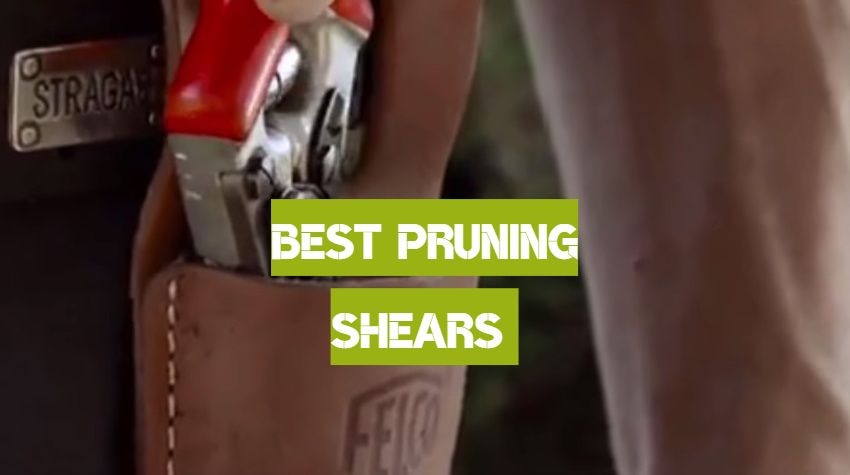




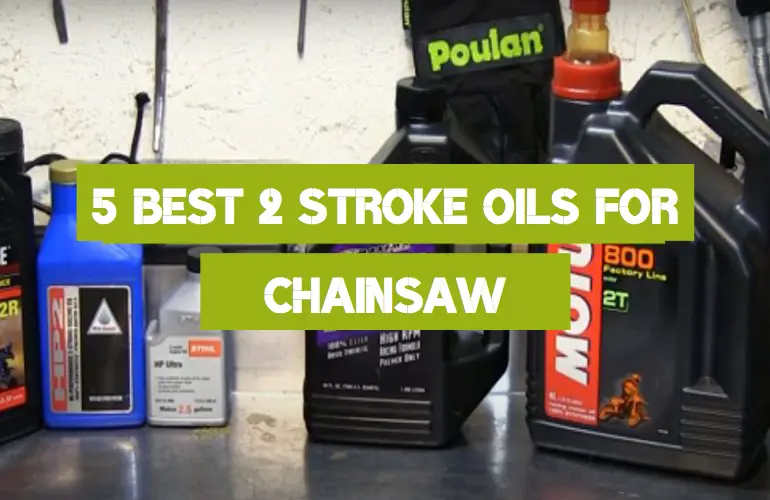
I actually own the Felco F-5 pruning shears shown here in the article. They are basic, but they have worked well for my needs. They have proven durable and rust resistant, and have been easy to secure in my hand when using them for long periods. You can pick up a pair online or in most hardware stores.
If you are looking to get the very best pruning shears I would highly recommend checking out the VIVOSUN 6.5. These have been my favorite shears ever since I got them and have had no complaints. They’re extremely sharp and will surely work great for you.
Although it’s got a crazy name (Corona), the BP 3180D is pretty nice. It’s a durable tool especially when you lubricate it after each use. It’s no wonder this has a lifetime warranty – it will last a lifetime for sure.